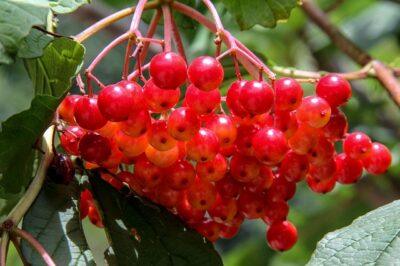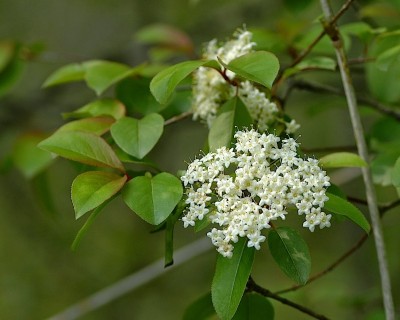Viburnums are attractive, large, shrubby plants that grow in woodlands, and they have a rich history of medical use. Let’s take a look at two of the most common viburnums and discover how they are used for healing.
Cramp Bark
Cramp bark – viburnum opulus – relieves muscle spasms and cramps. It reduces inflammation and promotes relaxation.
While not usually employed for cardiac health, cramp bark can reduce blood pressure, possibly due to its ability to soothe and relieve discomfort. Its astringent actions tone tissues, reduce swelling and staunch bleeding.
Cramp bark reduces discomfort of voluntary and involuntary muscles. Voluntary muscles are the ones that we use when we move. Hence, the herb helps to relieve pain when muscles are overworked or strained. Tension of the involuntary muscles is reduced when cramp bark is employed, and it relieves spasms of the urinary and digestive systems.
It also relieves menstrual cramps by promoting relaxation of muscles. The herb has been employed to help regulate menstrual cycles. Cramp bark’s astringent actions help to decrease excessive menstrual flow. The herb has been used for centuries as an aid to prevent miscarriage.
Current research supports the herb’s historical use as an aid to relieve spasms and cramps. Scientific studies prove that the plant is an excellent source of antioxidants. Cramp bark has antimicrobial actions and may be useful for preventing and treating infections. It is being investigated as a potential agent to treat colon cancer.
Safe and effective use of cramp bark
As the name indicates, the most commonly used medicinal part of the plant is the dried bark. Fall and spring are the best times of the year to harvest bark. The berries and leaves are used in China to regulate digestive function and as a source of Vitamin C.
Could This All-Natural ‘Detox’ Capsule Have Extended John Wayne’s Life?
The herb does not appear to interact with medications. Cramp bark is well-tolerated and safe. While the berries are used by some individuals, it is not recommended as they may be poisonous.
Black Haw
Like its cousin cramp bark, black haw – viburnum prunifolium – is used to relax the uterus. It relieves painful menstruation and is used by herbalists to help prevent miscarriage. Women who suffer from menstrual discomfort in the lower back or have “back labor” may find black haw to be particularly helpful. It relieves stagnation and congestion of the pelvic organs.
Black haw is beneficial for women who are menopausal or pre-menopausal. It can help to regulate cycles.
Midwives recommend its use as an aid to help women in labor. The herb relieves leg and sciatic pains, which are common during late pregnancy. Black haw also is helpful for decreasing pain which is due to uterine cramping after giving birth.
Black haw relieves hypertension by relaxing the peripheral blood vessels. Its antispasmodic characteristics make it a valuable remedy for the treatment of persistent hiccoughs.
Research shows that black haw contains an aspirin-like compound which reduces pain and fever. Unlike aspirin, black haw does not increase the risk of bleeding. The herb has been proven to have antibacterial properties.
Because black haw has strong antispasmodic actions, it is an excellent remedy for asthma. It reduces tension in the airways. Constricted passages open up. Breathing becomes less labored and more efficient. In addition to directly opening airways, black haw is calming, which can also help make breathing easier.
The Hidden Secrets Of Making Herbal Medicines…Right At Your Fingertips!
Native Americans historically used black haw to lower fevers and reduce muscle spasms. Poultices of the leaves were applied for skin disorders. The Shakers used black haw as a diuretic.
Safe use of black haw
The dried bark of black haw is the part most commonly used. Berries should not be consumed, as they may cause nausea.
Conclusion
Cramp bark and black haw have well-documented histories of safe use. They are particularly helpful for reducing muscular pains and spasms. Both herbs may be safely used for the treatment of menstrual cramps and muscle spasms by most people. However, we strongly recommend that cramp bark and black haw, as well as any other herbs, only be used under the guidance of a well-qualified health care provider who has expertise in the field of herbal medicine.
Have you used cramp bark or black haw? Share your tips on them in the section below:
Harness The Power Of Nature’s Most Remarkable Healer: Vinegar
 Off The Grid News Better Ideas For Off The Grid Living
Off The Grid News Better Ideas For Off The Grid Living





